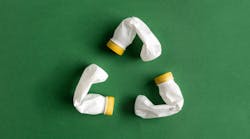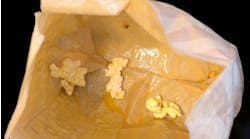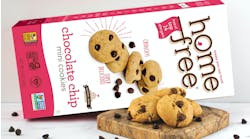Closed-loop recycling, so far, has been a Holy Grail—one made out of recycled plastic.
The recycling rate for bottles made from polyethylene terephthalate (PET), the most common form of plastic beverage packaging, currently hovers at about 28%. But most PET recycled from bottles gets “downcycled” into non-packaging uses, most commonly textiles. Closed-loop recycling, whereby PET bottles are turned into fresh bottles or other packaging, is relatively rare.
The stakes are high. Closed-loop recycling is, at least in theory, the only viable way to get a grip on plastic pollution, because downcycling into textiles or durable goods can’t keep up with the production of PET bottles and containers for water, soft drinks and many other kinds of beverages and foods. And plastic pollution is getting worse—or at least is edging upward in the minds of consumers. According to one estimate, by the year 2050, so much plastic trash will end up in the oceans that it will literally outweigh marine life.
Governments are providing recycling incentives, led by California, which last year passed what has been touted as the world’s toughest recycling law. Requirements for post-consumer recycled content on all packaging in the state will be 15% beginning Jan. 1, 2022, increasing to 25% in 2025 and 50% in 2030.
The major soft-drink companies have the will to accomplish closed-loop recycling – or at least they say they do. Coca-Cola pledges to have 50% recycled content for its soft drink packaging by 2050 (although that includes cans, which are far easier to recycle). It has 13.2-ounce bottles of Coca-Cola, Diet Coke and Coke Zero with 100% recycled PET (rPET) on sale at convenience stores in the Northeast, Florida and California, with a nationwide expansion due this summer.
PepsiCo has announced a goal of 25% recycled content in all beverage bottles by 2025, and Keurig Dr Pepper says it will cut its use of virgin plastic by 25% by 2025. More broadly, 52% of CPG companies surveyed by McKinsey made pledges to increase the use of recycled content, although only 28% committed to a specific percentage for its use; those averaged out to 52% of total content.
This is in response to consumer demand, says Martin Rathgeber, director of engineering, Studio One Eleven, Berlin Packaging.
“There is a growing trend in customers asking about sustainability and sustainable solutions in general,” Rathgeber says. “While larger CPG companies have been very publicly announcing tall sustainability goals, smaller and mid-size companies also have been listening to their own consumers who demand more environmentally sound practices and products.”
But even where there’s a will, there isn’t necessarily a way.
Companies have pledged to use recycled content before. Coca-Cola announced in 1990 that it would use at least some bottles made from 25% recycled plastic, but it quietly phased them out four years later. PepsiCo met a promise to include 10% recycled material in its bottles in 2005, but couldn’t live up to a promise to increase the overall soft drink container recycling rate to 50% by 2018.
The proportion of recycled plastic for all its packaging, food as well as beverages, stood at 4% in 2019, according to Tom Mooradian, senior manager for environmental sustainability.
Where’s the rPET?
The major problem in fulfilling those early pledges was a lack of rPET. “The availability of rPET played a large role in us not meeting our goal” of 1990, Coca-Cola said in a statement. “This miss was an opportunity to learn.”
That problem resulted from a lack of recycling availability. When it comes to packaging that comes in direct contact with food, recycled plastic must be processed in an FDA-sanctioned manner, meaning that processors must get a letter of approval (technically, a “no-objection letter”) from the agency. In the 1990s, only 14 plastics processors received FDA approval for recycling PET for food-contact applications.
Another five got approval for non-contact applications, meaning that the containers made from the recycled PET have to be separated from the product by a layer of virgin material. That reflects how some companies tried to deal with the limited supply of food-contact rPET by developing multilayer bottles, with an inner layer of virgin resin and a shell of recycled – in effect, a bottle within a bottle. But these proved too expensive.
Ice River Springs, a Canadian bottled water company, operates its own recycling and blowmolding equipment to allow it to offer water in 100% recycled PET. Photo: Krones
The biggest challenge is ensuring that the recycled plastic is pure. The surest way to do this is through chemical recycling, which involves deconstructing the plastic, so to speak – breaking it down to the monomer, or molecular, level. This kind of processing results in resin that’s almost indistinguishable from virgin plastic. It is, however, too expensive for most applications. Of the 242 plastic recycling processes that have been approved by the FDA, only 21 were for chemical recycling.
Far more common is mechanical, or physical, recycling. This involves shredding bottles (or whatever is being recycled), washing the material, melting it down and forming it into resin pellets. It’s simpler (in theory) and cheaper than chemical recycling. The problem is that it depends on strict segregation and inspection of the recycled material, to be sure not only that it’s the right resin, but that it is free of contamination, either within the plastic or from its contents.
If done properly, mechanical recycling yields rPET that, in terms of handling and forming, performs just like virgin. “The machine [blow-molder] doesn’t care if it’s rPET or if it’s virgin resin, it will make a bottle,” says Jon Larson, head of plastics technology sales for Krones USA.
There are some differences, primarily in color, Larson says: “When you process PET over and over, it does degrade. What that does is shift the viscosity and it also shifts the color value, depending on how many times that plastic has been melted and reformed. Depending on the percentage you use in your bottle, it may affect the color profile of the bottle.” That’s why rPET isn’t practical for clear plastic containers.
Can’t get enough
But the biggest problem with fulfilling demand for rPET is availability. As consumers and trade customers put a higher priority on sustainability, food & beverage manufacturers are scrambling to keep up. Many of them are perfectly willing to pay the premium for food-grade rPET (up to 10 cents per pound more than virgin), but they just can’t get enough of it.
This line, at a recycled-bottle supplier in the Los Angeles area, washes shredded plastic bottles before they are melted into recycled PET.
“There simply isn’t enough of the quality of material that is needed for this packaging, especially food-contact packaging, that is available in the marketplace,” says Meghan Stasz, vice president for packaging and sustainability with the Consumer Brands Assn. “The demand versus the supply are vastly different.”
That’s the case even though the supply of raw plastic material – the used bottles – went up sharply following the decision by China, in 2018, to close its borders to recycled material. Not only did that decision remove the biggest buyer for America’s recycled trash; it exposed the inadequacy of the entire U.S. recycling system.
“For at least the past decade or two, the recycling industry very much built its business model around that one single customer, which was China,” Statz says. “Because we’ve been sending the vast majority of our material to China, there’s really no ability, or very limited ability, to process many kinds of material here in the U.S. and turn that back into packaging or some other kind of value-added product.”
Pointing fingers
When you try to deconstruct who bears responsibility for the relatively low rate of recycling, you get a lot of finger-pointing. The only thing everyone agrees on is that there’s a lot of the raw material around, but it’s just not getting processed.
Coca-Cola’s 13.2-ounce 100% rPET bottles, available in selected markets, tout (inset) their use of recycled material.
“There is not enough recycled content available to meet increased demand,” Coca-Cola said in a statement. “One reason is that not enough plastic is currently getting recycled. We need more PET recycled so that we can turn that into rPET bottles.”
There are some beverage processors who have achieved success with recycled content by being in charge of their own recycling. Ice River Sustainable Solutions, a bottled water company in Shelburne, Ontario, has been using 100% rPET bottles for more than 10 years; they have their own recycling facility that buys post-consumer PET and turns it into bottles.
The environmental nonprofit As You Sow advocates for a greater degree of responsibility on the part of beverage bottlers. It frames the issue as one of reluctance by bottlers to use recycled-content packaging in the first place.
“This is an issue of companies not taking the necessary responsibility to make sure their goals can be implemented,” says Kelly McBee, waste program coordinator for As You Sow. “With recycled content, companies either need to commit to paying more for recycled content or dramatically increase their investment in collection and processing infrastructure to ensure there is enough high-quality supply to meet demand.”
As You Sow suggests companies will have to pursue strategies in addition to using recycled content, such as reducing material use, limiting future plastic use, designing for recyclability and transitioning to reusable and refillable packaging. Key to keeping them on track will be the increased attention paid to recycling.
“With much closer attention now being paid to company actions by activists, governments and citizens, we think there will be a lot more pressure on companies to follow through on their commitments going forward,” McBee says.


